Begonias
The Begonia family consists of more than 1930 species of tenacious and adaptable plants growing wild in diverse locations.
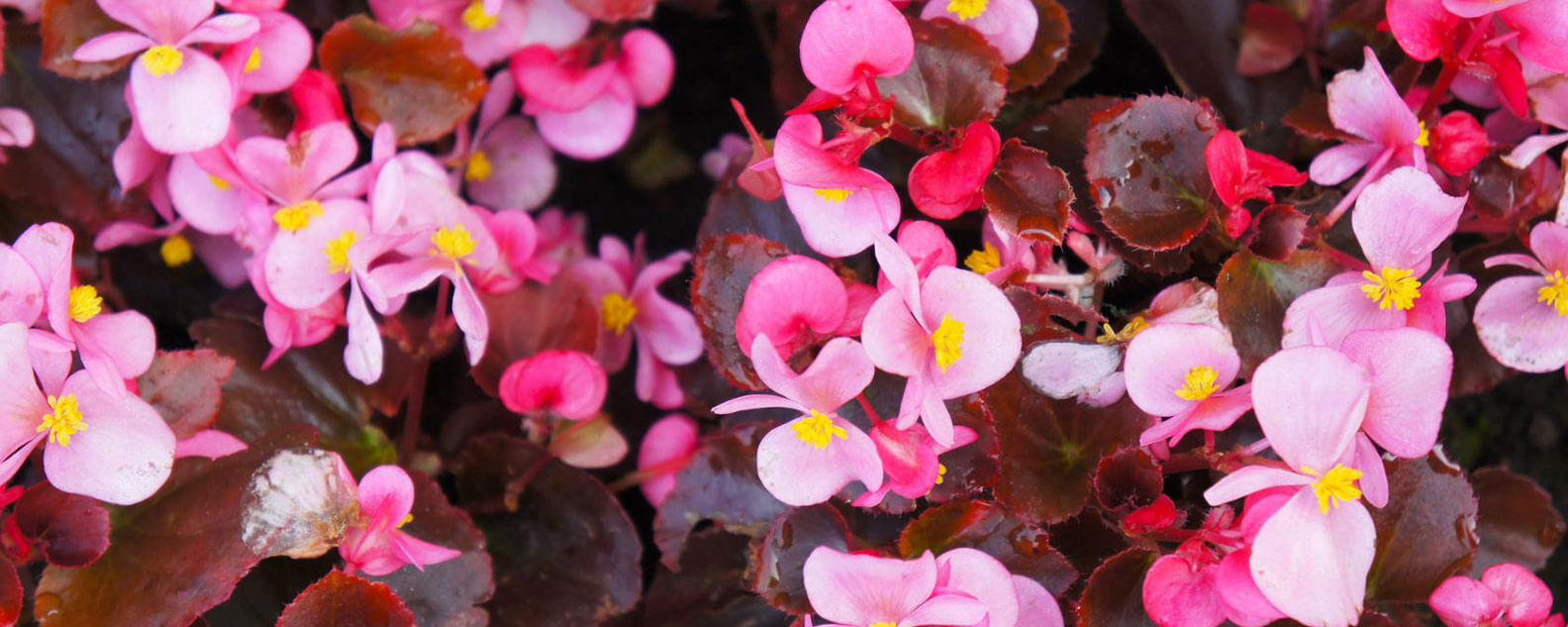
About the Begoniaceae family
Although some Begonias have adapted to dry and cold climates, they are most likely to be found living in low light on moist forest floors and cloud forest habitats in the tropical and sub-tropical regions of the world.
A French monk, Charles Plumier, collected the first wild Begonia to be described and drawn. Plumier botanised plants of economic and medical interest on behalf of King Louis the XIVth in the Caribbean in 1689-90. He named the specimen after his patron, the Governor of the French Caribbean colonies, Michel Bégon de La Picardière.
Begonias have been collected in Africa, South and Central America, India, southern China, Vietnam, Malaysia, the Philippines, Indonesia and Papua New Guinea.
Although Begonias face fierce competition for light and nutrients on rainforest floors, their habitat is inherently moist. Instead of putting energy into growing deep roots, they have adapted to grow large leaves which help them to catch as much of the low light as they can.
Water-loving Begonias may also be found in the wild on steep slopes or rocks near waterfalls and streams, or in damp caves. There are even epiphyte Begonia species that can be found clinging to trees and branches.
Begonias have asymmetric leaves, and their flowers are monoecious, which means that both male and female flowers are found on the same plant.
The Begonia’s ability to adapt to environmental triggers over many thousands of years has led to them being ideal for cross-breeding and propagating, and thousands of hybrids have been bred both commercially and by hobbyists.
Begonia is both the common name and the botanical name for all members of the genus. Begonia varieties have been separated into nine distinct sub-groups to make them easier to describe. Their differing habits offer many and varied blooms, some of which are lightly fragranced, and striking foliage that is often textured, which makes them an exciting plant for home gardeners who want to get to know a single plant family.
Begonia varieties
Rhizomatous
Compact and grown for their highly patterned and textured leaves and stems, Rhizomatous Begonias grow from a ground-stem or rhizome
Rex
Rex Begonias are a type of Rhizomatous Begonia grown for their dramatic, multi-coloured foliage
Semperflorens
One of the Begonias that can be eaten raw, Semperflorens are used as bedding plants because of their abundance of flowers
Shrub
This group branches often, has a low-growing habit and interesting foliage which may be hairy or velvety
Thick-stemmed
One of the lesser-known varieties, if you like foliage and branches this may be the plant for you. They do not flower often, need more room, like more light and have deeper roots than other Begonia types.
Trailing
These Begonias are grown as ground covers and climbing plants. They are ideal in hanging baskets because of their trailing habit and will also grow up posts and trellis’ with a bit of help.
Tuberous
Tuberous Begonias have been bred to have large, eye-catching flowers. Some of them die back in winter and emerge from their tubers again in Spring
Elatior
This Begonia type is the result of cross-breeding experiments with winter flowering species that could be grown indoors in the early 1900s. They now grow year-round and are prized for their blooms
Cane
Cane Begonias have long stems with swollen nodes that resemble bamboo. They are grown for both their foliage and their flowers.
Are Begonia flowers edible?
Yes! The rumour is true, First Nations Peoples have been using Begonias in their plant medicines for thousands of years, and the leaves and flowers of some species are edible too. They have however adapted to produce high levels of oxalic acid to protect themselves from insects and herbivores, so please make sure to check that yours is edible before you nip out to the garden to forage a salad and consume your Begonia in moderation.
Bright ideas for potted colour
If you’re always wondering what other uses you can put your plants to, oxalic acid is a mordant used to fix plant dyes, so there’s potential for your Begonias to yield even more joy and colour when you prune or uproot them at the end of the season.
In the hard-to-find Dyes from Plants of Australia and New Zealand (1971), Joyce Lloyd says scarlet Begonia flowers yield a bright pink when mordanted with alum. If you decide to experiment, remember to wear gloves, keep your dye pots separate from your food pots and work in well-ventilated spaces.
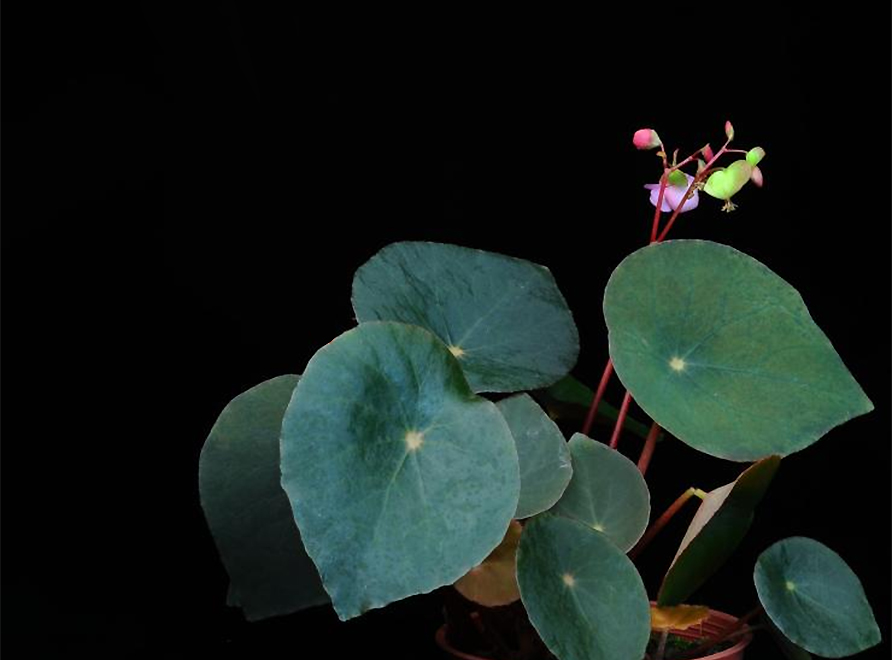
Begonia taraw
Begonia taraw
A rare and endangered plant
Intrepid plant hunters on a quest for tropical plants that have never been seen outside their native habitats may sound like the plot of a period drama. However, naturalists still find unique specimens when botanising in the field.
Two specimens of the Begonia taraw were collected by botanists in the wild in a national park on the Philippines' Palawan Island in November 2011. Its species name B. taraw was formally published in 2015.

Begonia taraw's habitat
The species epithet 'taraw' means Kast Limestone in the language of the Tagbanua people of the island.
This rare Begonia likes to live dangerously, growing on steep, moist limestone cliffs in the semi-shade of a broadleaf forest near the mouth of Palawan's Puerto Princesa underground river. B. taraw was also found in a cave semi-shaded by tropical forest nearby.
Although protected due to its location in a National Park, B. taraw is critically endangered and listed on the IUCN Vulnerable list due to the threat of rapid habitat loss in the Philippines.
B. taraw has fleshy, broadly ovate leaves and grows to 10 cm. Its leaves are discolourous – mid-green on top and red underneath.
Clusters of flowers in pink to white shades are arranged in cymes 50 cm above the leaves with a central male flower and lateral female flowers up to 2 cm in size with 3-winged ovaries. The female flowers branch up to six times, maturing successively, and there is a ring of fleshy hairs at the base of the flower's stem. The fruit of this tenacious Begonia is a 3-winged papery, pale brown capsule.
A single B. taraw specimen has been cultivated in Taiwan and flowered from summer to autumn. The plant was fruiting and flowering in November 2011 when the first specimens were collected.
Garden Sign Story – Tropical Troughs
High in rocky mountain regions, some begonias endure dry seasons and frigid temperatures below -20°C. Far below, there’s fierce competition for light and nutrients on the rainforest floor: Begonias living there don’t waste effort on deep roots – instead they grow large leaves to catch maximum light. Other water-loving types live dangerously, on steep slopes or rocks near streams and waterfalls, or inside damp caves. And some are epiphytes – clinging to tree trunks and branches.
Garden sign image: Begonia taraw brown and green individuals growing at a cave entrance, PPSRNP, Sabang, Palawan, Philippines.

Palm-leaf Begonia – Begonia luxurians
Palm-leaf Begonia
Begonia luxurians: A perfumed, shade-loving plant
Also known as the Palm-leaf Begonia, Begonia luxurians is a spectacular evergreen cane-stemmed species from Brazil that can reach heights of up to 2.5 m.
This beautiful plant is used as a herbal medicine by the First Nations Peoples of Brazil.

Begonia luxurians' habitat
B. luxurians is one of the 'cane' Begonia varieties, and its height and shallow roots mean its stems will need staking to prevent them from snapping if they get too tall. Because of its height, it also benefits from an annual prune to remove any growth that looks leggy and unkempt.
The Palm-leaf Begonia offers interesting foliage and fragrant flowers in spring and summer. Its shallow roots are ideal for pots or containers as long as you provide dappled light, constant moisture, good soil and drainage. It’s a great plant to integrate into your potted garden If you live in an apartment with a balcony or courtyard.
The species epithet 'luxurians' is derived from the Latin ‘luxus', which references its luxuriant abundance of leaves and flowers.
The Palm-Leaf Begonia hails from the rainforests of south-eastern Brazil in Rio de Janeiro and Sao Paulo.
Like most tropical plants it is frost-tender and will thrive in an environment with consistent humidity and moist, fertile, well-drained soil. Found in the understory of rainforests, B. luxurians will be most likely to grow well if you have a spot with indirect sunlight or bright shade and some early morning sun.
B. luxurians leaflets are slender and serrated, creating palmate leaves up to 45 cm wide. Stems are thick and visually akin to bamboo. They are discolourous with a green upper and a reddish-bronze underside which folds upward lengthwise.
The new leaves and stems of this decorative plant have a pink-red tinge, and the fragrant flowers are small, creamy-white with yellow stamens, growing in cymes above the foliage from late winter to summer.
Visit the Garden Explorer and type 'Palm Leaf Begonia' into the 'Common or Scientific Name' field, then click 'search' to be shown where they can be found in the Garden.
Garden sign story: Begonia luxurians
With fierce competition for light and nutrients on the rainforest floor but plenty of water, begonias don’t waste effort on deep roots – instead, they grow large leaves to catch maximum light.
In 2020 over 90 begonia species were on the IUCN list, of which 40 species are either endangered or critically endangered due to habitat loss and illegal collection.
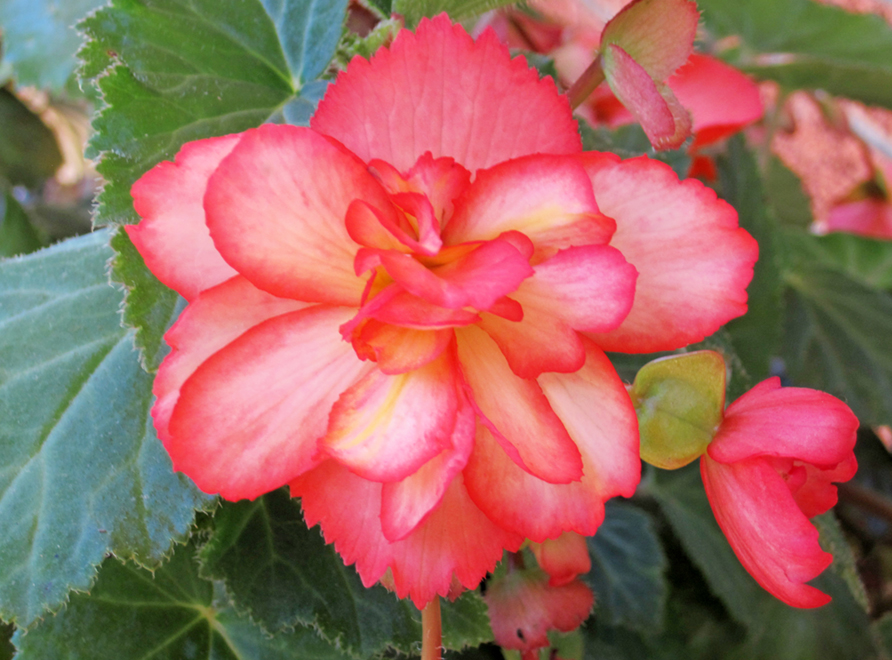
Tuberous Begonia
Tuberous Begonias
They're bloomin’ delightful
Begonia x tuberhybrida Syn. Begonia × tuberhybrida Voss
The ancestors of today's Tuberous Begonias, which were native to the Andes of Central America, are an exquisite example of plant evolution. These tenacious plants adapted to their cold climate by creating tubers to store nutrients so they could go dormant during winter and emerge with vigour when the days grew warmer.
The first Begonia x tuberhybrida was developed in the 1870s by crossing (interbreeding) the Begonia boliviensis, Begonia pearcei and Begonia veitchii. The parents of this original hybrid were all native to the Andes in Peru and Bolivia, enjoying moderate daytime temperatures and cool nights.

Tuberous Begonia's habitat
These Begonias are grown for their vibrant, showy flowers, which bloom from summer to autumn, offering great value for the home gardener on a budget. They're most often used for seasonal bedding displays and potted colour in shady spots with dappled light and places that only get morning or late afternoon sun.
They are frost-tender but don't despair if you're in a cool climate; they are also ideal as hanging plants and do well in indoor container gardens if they get at least four hours of indirect sunlight a day. Growing them indoors may reduce their flowering duration.
Growing begonias isn't hard, but there are a few things you can do to avoid common issues.
Deadheading will prevent rotting flowers from causing disease.
If your plant looks leggy, move it to a spot that gets more light.
If the leaves are turning brown and drying out, your green friend may be getting too much direct sun and needs to relocate to a spot with dappled light.
Begonia x tuberhybrida has a winged seed capsule containing thousands of seeds that form behind the female flowers.
Because these are hybrid cultivars, their seeds may produce plants that vary from their parents, offering an exciting opportunity to grow new forms if you're a patient gardener who likes to experiment.
If you love your plant as it is and want more, true-to-type propagation is possible via tuber division or leaf cuttings.
The name of the hybrid group is from the Latin 'tuber', which means protuberance, bump or swelling and ‘hybrida’ which tells us they are of mixed origin.
Begonia x tuberhybrida cultivars are grown commercially in nurseries worldwide and only exist as the result of cross-breeding, which means there are no examples of them in the wild.
Modern hybrid Tuberous begonias enjoy the shade and do not do well in areas prone to frost.
The plant's flowers are waxy and come in shades of white, yellow, apricot, pink and red. Begonia x tuberhybrida's male blooms are the show stoppers; they're doubles and grow up to 15 cm. Commercial growers will often remove the two female flowers that accompany the male, enabling the plant to put more of its energy into creating a dramatic display.
Although they are not on permanent display in the Garden, they are sometimes included in exhibition plantings in The Calyx.
Garden sign story: Begonia look-book II
Tuberous begonias have the largest and most spectacular flowers of all. Often, they die back in winter, sprouting anew from a tuber in spring.
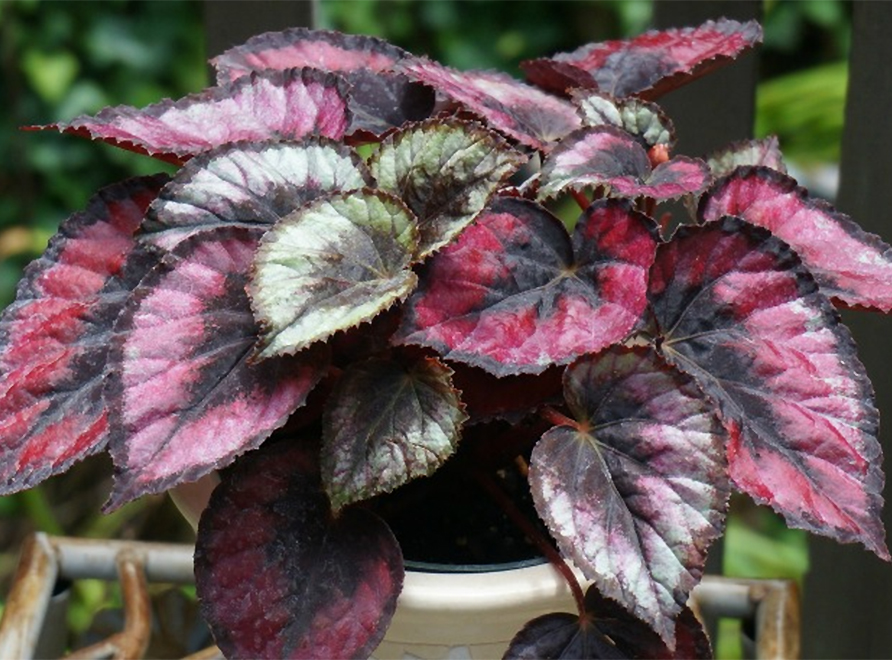
Begonia rex
Begonia rex
The king of potted plants
Syn. Begonia rex-cultorum
The arrival of the first Rex Begonia in the West was a happy accident; it was unintentionally transported with a collection of orchids sent to Europe from Assam in northeast India in 1856. The Rex Begonia varieties we know today are all hybridised descendants of that stowaway.
Begonia rex: The ideal house plant
They are highly prized for their vivid textured foliage and are most often grown as indoor plants or greenhouse container specimens. Although they have a reputation for being finicky and hard to grow because they require high humidity, a warm microclimate and a meticulous watering routine, Begonia rex hybrids' love of filtered light makes them ideal house plants. Popular cultivars include Begonia 'Escargot' and Begonia 'Black Magic'.
Begonia rex has been used medicinally and as a food source in its original habitats but is reputed to be toxic to dogs, cats and horses.

Begonia rex's habitat
Gardeners can easily propagate from seed, however Rex Begonias are crossbred, so their offspring may not be the same as the parent plant. If you want a true-to-type plant, your only option is clonal propagation by leaf cutting or rhizome sections.
The epithet 'rex' is Latin for the ‘king', giving us some insight into this evergreen hybrid group's position as the jewel in the crown of Begonias.
The wild ancestor of our modern Begonia rex cultivars was collected in Assam in the Himalayas. The plant is native to northeast India, the eastern Himalayas, southern China, northern Myanmar and Vietnam. It is found in rocky, moist, subtropical forested valleys and slopes with filtered light, high humidity and no frost.
Rex Begonia's hybrid descendants are now cultivated in nurseries worldwide.
Rex Begonias are evergreen, rhizomatous perennials that grow to 50 cm. They are renowned for their variously patterned, veined, coloured and textured foliage, and their leaves can grow up to 30 cm. Stems are long, erect, succulent and hairy.
Although Rex Begonia varieties display clusters of small pale pink or white flowers in spring, summer or autumn, the vibrant leaves are the star of this show. The plants produce a dry, three-sided, winged seed capsule which contains seeds that look like rust.
Begonia ’ Black Magic’ is planted in the Middle Garden, use the Garden Explorer to find it – type 'Black Magic' into the 'Common or Scientific Name' field, then click 'search' to be shown where to find them. Other cultivars sometimes feature in displays at The Calyx.
Garden sign story: Begonia look-book II
Begonias are all kinds of beautiful. Flowers are usually the star, but fabulous leaves can steal the show.
Rhizomatous begonias are usually quite compact in size, with leaves growing from a ground-stem or rhizome. Many have beautifully patterned and textured leaves. Rex begonias are a type of rhizomatous begonia, grown for their stunning multicoloured foliage.
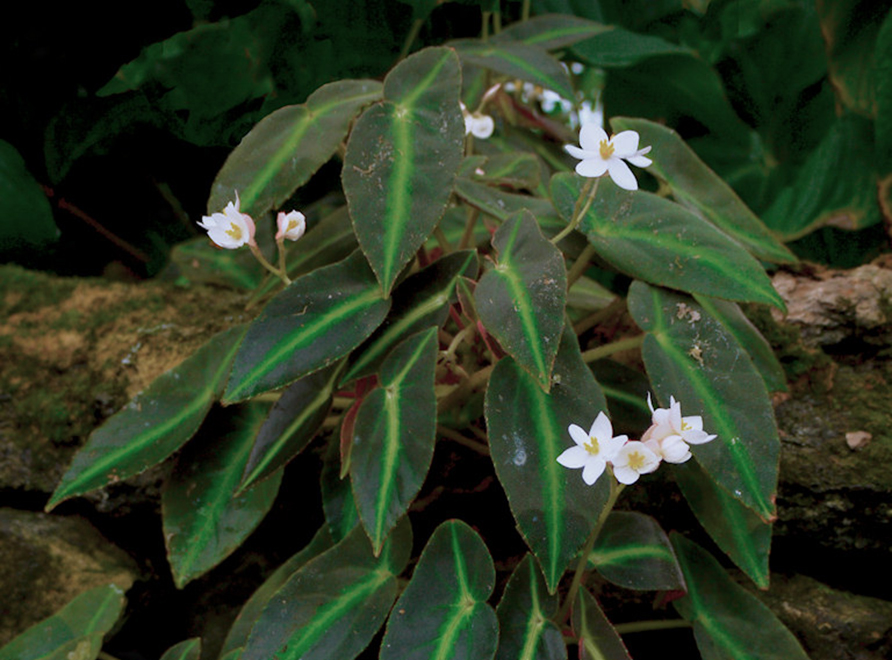
Begonia listada
Begonia listada
The Botanic Gardens' perennial groundcover
Also known as the Candy Stripes or Striped Begonia, Begonia listada is a compact, evergreen semi-shade-loving plant native to the moist rainforests of central South America.
It has been cultivated since the 1960s and is a firm favourite as an indoor pot plant because of the drama of its dark green velvety leaves with light green stripes and deep red undersides. This eye-catching species makes for a great indoor hanging plant.
Begonia listada has also been used as a mass-planted ground cover under trees at the Royal Botanic Garden Sydney.

Begonia listada's habitat
Plant in a semi-shaded location with soil enriched with well-composted organic material
Protect from snails, especially when your plants are young
Provide regular applications of slow-release fertiliser.
The epithet 'listada' is Spanish for 'striped'.
The native habitat of B. listada spans southern Brazil, Paraguay and northern Argentina.
It is found in the understorey of subtropical rainforests and enjoys filtered light, high humidity, and moist soil that is rich in nutrients.
B.listada or Begonia listada is a compact, bushy evergreen perennial that grows to 30 cm tall. Its leaves have a bright green midrib and a deep red underside which is thought to reflect sunlight into the plant, assisting with photosynthesis. The contrast in foliage colour is enhanced when planted in acidic clay soil.
B. listada's leaves are elongated, asymmetrical, hairy and have the texture of velvet. It produces panicles of white flowers throughout the year in subtropical climates, but it needs bright, indirect or filtered light to put on a good show.
The plant's fruit is a three-sided capsule containing an abundance of tiny seeds which can be propagated easily.
There are mass plantings of Begonia listada at the Royal Botanic Garden Sydney.
Type 'Begonia listada' into the 'Common or Scientific Name' field in the Garden Explorer, then click 'search' to be shown where to find them.
Buy a Begonia listada and support the Botanic Gardens
If you want to see this vibrant ground cover in your garden or hanging baskets, pop down to the Growing Friends Nursery and support your Botanic Gardens by purchasing one (or more!).
Garden sign story: Striped Begonia Begonia listada
Red benefits
Some Begonia leaves have red pigments (anthocyanins). These pigments reflect harmful ultraviolet and infrared light — a handy ability in exposed mountaintop locations.
Growing wild in the dim depths of the Brazilian rainforests, the red undersides of the Striped Begonia’s leaves give them an advantage: light that travels through each leaf doesn’t escape; it’s reflected back into the interior for a second chance to be absorbed.
Red leaves may also provide protection against herbivorous insects – studies have shown insects tend to prefer the colour green!
Acid blush
Plants growing in acidic clay soils produce the brightest leaves in red, pink and purple hues.
Image: Begonia listada is perfectly adapted to thrive in deep shade. Image: ©J. Plaza

Begonia x semperflorens
Begonia x semperflorens
Waxing lyrical about bedding plants
Begonia x semperflorens-cultorum
Also known as Wax Begonias or Bedding Begonias, the wild parent species of the Semperflorens group was introduced to European growers from Brazil in the 1820s. Many cultivars have descended from the parent species through hybridising and selection for desirable traits.
Wax Begonia flowers are edible!
The flowers have lime, lemon and green apple flavours. The First Nations Peoples of South America use the plants in herbal medicines for pain relief, anti-fungal and anti-bacterial preparations. Recent scientific research has found these time-honoured medicinal uses to be well-grounded.
The roots are, however, poisonous and contain soluble calcium oxalates, which can lead to kidney stones and mineral deficiencies.

Begonia x semperflorens' habitat
Although they are often grown as annuals to bring a splash of potted colour to a mass planting, Begonia Semperflorens group are short-lived perennials. They are gregarious and do best planted in clusters.
Their love of light shade and shallow roots make them ideal for plantings under trees because the trees' roots won't be interfered with; the trees will also protect them from frost if you live in a cooler climate. This combination of qualities makes Wax or Bedding Begonias an ideal plant for container gardening on balconies or patios.
These delightful plants will also adapt to full sun in mild climates but need well-drained soil.
Planting them a bit deeper in the soil than they were in their original container will trigger the newly buried stem to sprout additional roots which makes for a stronger, healthier plant.
Semperflorens are abundant bloomers with a long season. The epithet 'semper' is from the Latin for 'always' and 'florens' for 'flowering'.
You'll find the wild relatives of the Semperflorens group growing in filtered light on forest floors in the moist subtropical rainforests of Argentina, Brazil, Paraguay and Uruguay in South America.
The cultivars of the Semperflorens group grow in compact mounds to 30 cm tall. They have fibrous roots and soft, succulent stems, which makes them frost-tender. The foliage is rounded and waxy and ranges from green to bronze.
Like the Tuberous Begonia, the flowers are the bedding Begonia's drawcard. They will bloom in loose clusters of single or double flowers in shades of red, pink and white with yellow stamens for most of the year if you live in a subtropical climate. The flowers are 1-2.5 cm across, the females have 4-5 petals with a three-winged ovary below, and the males have four petals, two narrow and two broad.
Given the right conditions, when the female flowers' winged capsule splits to disperse many tiny seeds, this Begonia will self-seed easily. They can become weedy if you live in Sydney, which has the perfect subtropical climate for self-seeding.
Type 'semperflorens' into the 'Common or Scientific Name' field in the Garden Explorer, then click 'search' to be shown the current location of bedding Begonias in the Botanic Gardens.
Garden sign story: Bedding Begonias – Begonia semperflorens
Feast and cure-all
Many begonias are edible! The flowers, leaves and stems can all be eaten. They have a sour, citrusy taste and are known to be a source of vitamin C. But take care… just like spinach and some other vegetables, begonia leaves and stems contain oxalic acid. They have evolved this as a defence against insects and herbivores, but it is also toxic to humans. Steam or boil begonias before eating them.
Doctor Begonia
Begonias have a long history as ingredients in herbal medicines. Recent scientific research supports these traditional uses – finding many species contain compounds with antifungal and antibacterial properties.
Image: Begonia semperflorens can be eaten raw.
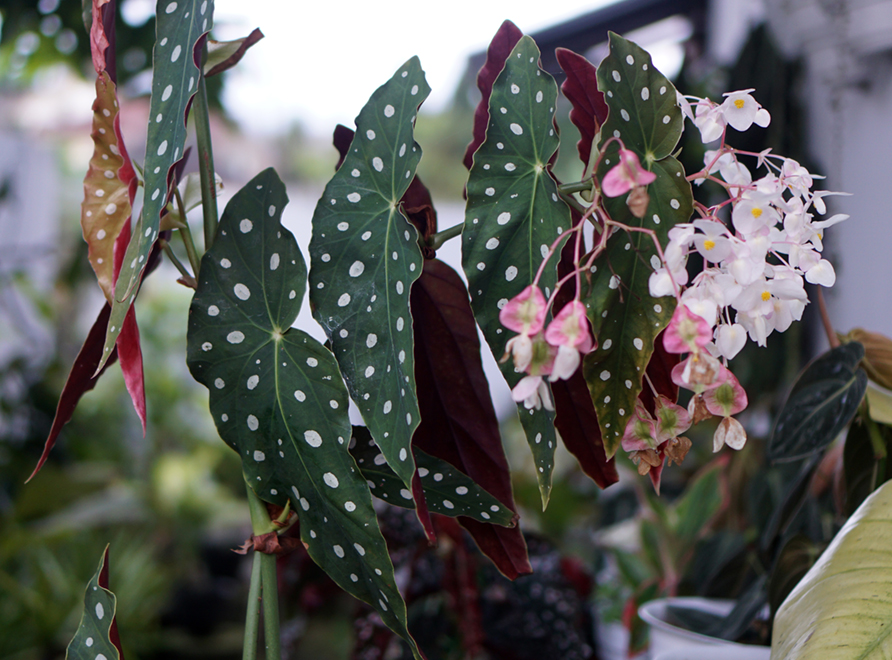
Cane-stemmed Begonia 'Irene Nuss'
Begonia 'Irene Nuss'
A superb cane-stemmed Begonia
Also known as Angel Wing Begonias, B. Irene Nuss is a cane-stemmed Begonia descended from parents in the Superba group. Amateur Begonia breeder Irene Nuss produced this cross between the Kentwood and Lenore Olivier cultivars at her home in California in 1971.
This cane Begonia is cultivated worldwide, its ancestors were moisture-loving subtropical and tropical plants that grew in filtered or low light.
Grow cut flowers at home!
If you have designs on a cut flower garden, B. Irene Nuss is a must-have; its dark green to bronze leaves bring understated elegance to floral arrangements.

Irene Nuss' habitat
B. Irene Nuss is a perennial, and the deep colour and texture of its foliage offer an ongoing source of delight. Cane Begonias are also known as Tree Begonias, and this cultivar has the potential to grow to 1.2 m given ideal conditions, which will bring drama to your containers or pots. Its preference for filtered light and warm, protected positions serves apartment and balcony gardeners well.
B. Irene Nuss is frost-tender and best suited to warm, sheltered spots, filtered light, sub-tropical humidity and moist soil.
Begonia ‘Irene Nuss’ is an evergreen, perennial with fibrous roots. It's a heavy feeder, so ensure you have fertile soil and regularly repot your plant if you're growing it in pots or containers.
Its leaves range from dark green to bronze and grow up to 20 cm long. They are waxy with deep lobes, which led to their alternative moniker, Angel Wing Begonias.
The flowers are mid-pink, with blooms growing up to 4 cm on hanging panicles. They have the potential to bloom year-round in a subtropical climate, which means Sydneysiders get more bang for their buck with these stylish plants.
The three-sided papery fruit capsule will split when dry, enabling the plant to self-seed. Because B. Irene Nuss is a hybrid If you want to grow another 'true-to-type' plant, you must propagate a clone from a cutting.
Type 'Irene Nuss' into the 'Common or Scientific Name' field in the Garden Explorer, then click 'search' to be shown its current location in the Botanic Gardens.
Take B. Irene Nuss home with you
If you love the look of 'Irene Nuss' and want to see it in your garden, visit the Growing Friends Nursery and pick up some plants. Your garden will look great, and your purchase supports the Australian Institute of Botanical Science's research.
Garden sign story: Begonia Irene Nuss
Hybrid of cultivars Begonia ‘Kentwood’ and ‘Lenore Olivier’
Larger flowers, brighter colours, unusual leaf patterns and shapes... there are so many new delights a plant breeder can create!
Begonia babies
New types of begonias are formed when pollen is carried between flowers of different species, creating hybrid offspring. It can happen in the wild, but breeders also ‘cross-pollinate’ to create new cultivars like Begonia ‘Irene Nuss’.
Once plant breeders have done all the hard work, it’s easy to multiply your own: Being succulent-like, begonias are very easy to propagate by stem and rhizome cuttings, and sometimes even leaf cuttings!
Please don’t pick the plants growing here. Why not visit the Growing Friends nursery instead?
You can buy many of our unusual begonia varieties at the<Growing Friends nursery nearby.
Image: The Growing Friends nursery
Buy Begonias at the Growing Friends nursery
Find rare and interesting plants at the Botanic Gardens' Growing Friends Nursery – the selection is seasonal, so don't be a stranger!
Every time you buy a plant from the Growing Friends, you're supporting the Institute's conservation research.